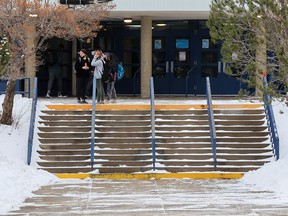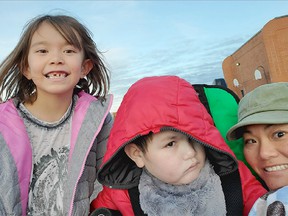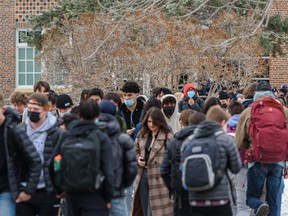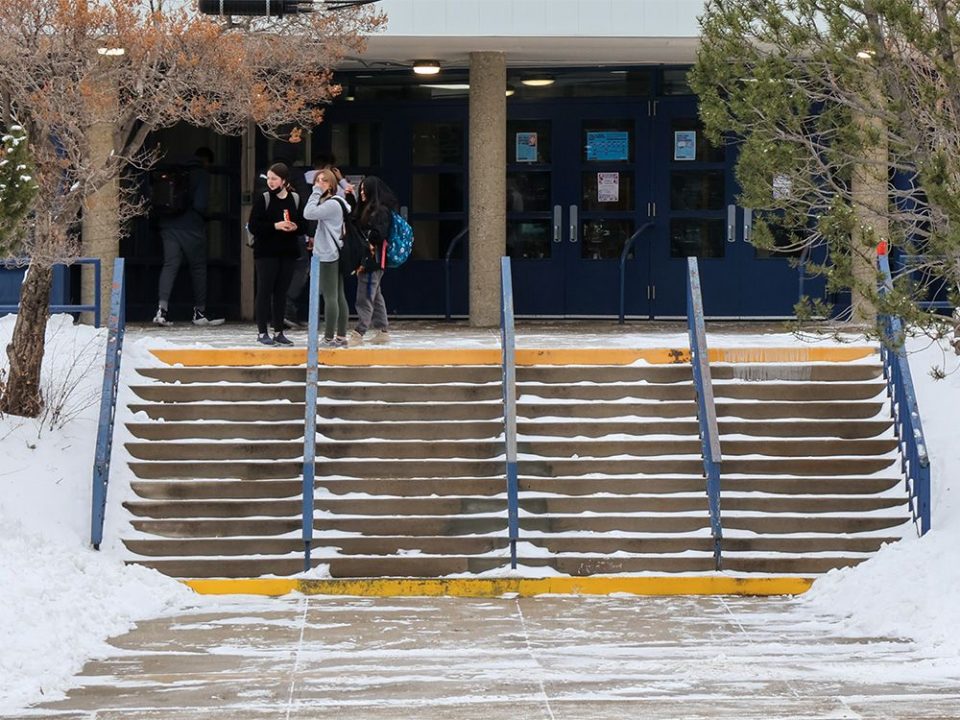‘Many children are diabetic, they may be taking multiple medications … They may be facing cancer, going through chemotherapy’

Article content
With the UCP government lifting COVID-19 restrictions this week, teachers can now join students in taking off masks at school, leaving at-risk kids and their families in a difficult spot, critics say.
Advertisement
This advertisement has not loaded yet, but your article continues below.
Article content
At the same time, the COVID virus remains ever-present in schools, according to data collected by both the Calgary Board of Education and the Calgary Catholic School District.
While cases are lower than the peak of the Omicron surge in late January, school districts have not seen a significant drop in cases overall since masking requirements were lifted for students in mid-February. And some individual schools are still seeing high numbers.
But new rules revealed this week, making masking optional for all “adults” in schools, mean any teacher, educational assistant or volunteer parent can now choose to not mask, creating fear and worry for the immunocompromised.
Dr. Mukarram Zaidi, a family doctor in southwest Calgary, fears COVID cases will continue to spread in schools, and cause serious illness in those who face risks, many of which are hidden.
Advertisement
This advertisement has not loaded yet, but your article continues below.
Article content
“Not everyone in the population is healthy,” Zaidi said.
“Many children are diabetic, they may be taking multiple medications; if not them, their parents may be. They may be facing cancer, going through chemotherapy.
“Yet we are seeing the lifting of restrictions for no reason other than politics. It is draconian what is being done to children.”
Fuyo Watanabe, whose eight-year-old son has complex medical needs and is at high risk of severe outcomes with COVID, said lifting restrictions makes her feel as though her family is being abandoned by the UCP government.
“Removing all mandates and restrictions is just a political move, and they are sacrificing our families in the process,” she said.
Watanabe’s son attends Emily Follensbee School, a unique CBE program for special needs kids where most students and staff are still masking.
Advertisement
This advertisement has not loaded yet, but your article continues below.
Article content
But Watanabe worries for her six-year-old daughter, who has no special needs and attends a regular public school.
“She is the only one in her class wearing a mask right now,” Watanabe said, fearing she could bring the virus home to her older brother.
“I understand the responsibility to protect ourselves is ours, and I don’t expect everyone to always make sacrifices for us.
“But is there not a middle ground where we could have helped the people that needed help without inconveniencing those who don’t want to wear masks,” Watanabe added, explaining that improved ventilation in every classroom would be a good compromise.

Amanda Hu, spokeswoman for Fresh Air Network which advocates for safer schools, says she is worried for vulnerable students, but also staff and their family members.
Advertisement
This advertisement has not loaded yet, but your article continues below.
Article content
“There is a lot of moral injury occurring in schools right now, even with teachers seeing some of their colleagues not masking, and thinking ‘this colleague knows I have a baby at home,’ or ‘someone in my family is immunocompromised,’” Hu said.
“It is everyone for themselves. But that is not how society works.”
Hu added there is no evidence cases are coming down significantly.
According to CBE data averaging K-12 absence rates over the past 10 days, numbers have seen two peaks, jumping from four per cent on Feb. 15 to as high as five per cent on Feb. 22, nine days after masking requirements were lifted for students.
Absences lowered slightly to 4.2 per cent on Feb. 25, but then ticked up again to 4.9 per cent Feb. 28, stayed steady throughout the week, and then bumped up again Friday, closer to five per cent, higher than averages before masking was lifted.
Advertisement
This advertisement has not loaded yet, but your article continues below.
Article content
K-3 students are experiencing the highest absence rates, peaking at 5.6 per cent this past week.
As well, some individual schools are also still seeing high absence rates, like Banting and Best, a K-6 school in Lynwood, which earlier last week had 14.5 per cent of students away because of illness.
At the height of Omicron, student absences overall averaged between 15 and 20 per cent, and staff absences were usually over 1,000 per day.
But at the end of this past week, CBE staff absences were at 926 Friday, with only 818 jobs filled by substitutes or casual staff.
CBE officials say absence rates are not much higher than they were before the pandemic, pulling figures from Feb. 28, 2019, when they say 2.85 per cent of students stayed home because they were sick.
Advertisement
This advertisement has not loaded yet, but your article continues below.
Article content
“While our current rate of student absence due to illness is higher this year, at around four per cent, it is not significantly higher,” said CBE spokeswoman Megan Geyer.

At CCSD, where self-reported COVID cases are tracked instead of absences, numbers have also not declined significantly over the past two weeks, and saw a slight increase one week after mask requirements were lifted for students.
Compared to about 90 daily cases on Feb. 14, that number rose to 120 by Feb. 22.
On Wednesday, CCSD reported an average of 257 student infections over the last 10 days earlier this week, with 71 schools still in active status. By Thursday, those numbers rose to an average of 281 infections in 83 schools.
But CCSD officials said living with COVID will be part of everyone’s reality going forward.
Advertisement
This advertisement has not loaded yet, but your article continues below.
Article content
“While COVID-19 may still be present in schools, our students, families and staff have learned a lot over the past two years. We all know to stay home if we are feeling sick. At school, we will continue to wash our hands regularly, sanitize high-touch surfaces and have the option to wear masks,” said CCSD spokeswoman Felicia Zuniga.
Jen Allan, a mother of three children just north of Calgary, two of whom are immunocompromised, says the lifting of restrictions this week has been overwhelming for her family.
“It’s an excruciating feeling, letting our children down, not being able to protect them as a parent should,” Allan said.
“Some kids might get a mild version of COVID, but some will be very ill and others will be hospitalized. And again many will suffer time lost at school due to illness.
“How can we as parents rationalize what is happening?”


